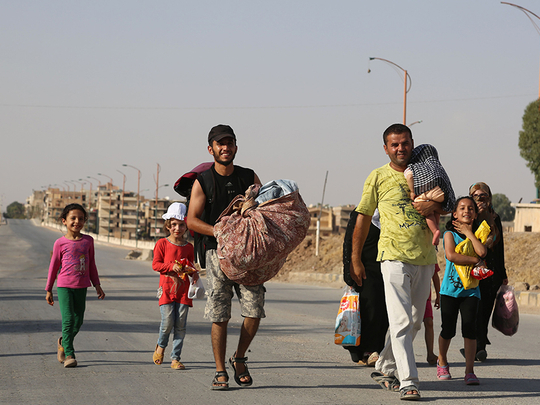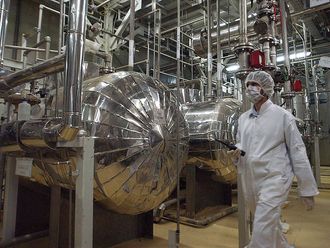
New York: The conflict and civil strife that has erupted across the eastern Mediterranean region since the Arab Spring began in 2010 has shortened lifespans and damaged health, according to a study released on Thursday.
Yemen, Tunisia and Egypt all lost about three months in life expectancy between 2010 and 2013, with deteriorating conditions threatening health gains made over the previous two decades, researchers said.
In Syria, life expectancy for men has declined by five years since the war there began in 2011, a new analysis of mortality data has found, a sudden collapse not seen since the decline that Russian men experienced after the end of the Soviet Union.
The analysis, by the Institute for Health Metrics and Evaluation, a health research group based at the University of Washington, used data from 22 countries in the Middle East and North Africa, as well as Pakistan and Afghanistan, to look at death and disease trends from 1990 to 2013. It was published on Wednesday in the British medical journal The Lancet Global Health.
The study found steady improvements in health in the region over that period. But the Arab Spring uprisings in early 2011 and subsequent upheaval disrupted that progress in a number of countries, namely Syria, Yemen, Libya, Egypt and Tunisia.
Life expectancy is a basic measure of well-being of a nation, and a sudden decline is often a sign of deep distress. Russian men experienced a six-year drop from 1991 to 1994, the years immediately after the breakup of the Soviet Union, according to the Human Mortality Database, as a severe economic decline resulted in a surge in suicides, heart ailments and alcohol-related liver disease.
Life expectancy had improved significantly in Syria in recent decades, reaching 74 years for men and 79 years for women by 2010. Infant mortality had declined substantially, and heart disease — the single biggest killer in most developed countries — had taken centre stage. But the war knocked men back to 69 and women to 76, amid a surge in deaths from violence, infections and even malnutrition.
“This is a region that, against all odds, had been doing very well,” said Ali Mokdad, a professor of global health at the Seattle-based institute. “That’s all being destroyed right now.”
There were about 30,000 deaths in 2013 that were casualties from the war, researchers found, about a third of the 100,000 total deaths in the country that year. He estimated that 11,000 more were associated with the war — including a lack of medical care, untreated infection and respiratory illnesses, and malnutrition. Heart disease was still the No. 1 killer, with about 42,000 deaths.
In some ways the findings are unsurprising. War takes lives, particularly young ones, slicing years off life expectancy, often suddenly. But the authors argued that quantifying the loss — an undertaking that involved stitching together different data sources and using mathematical modelling to fill in the gaps — would show just how devastating war has been for some of these societies.
The analysis also found declines in life expectancy for Yemenis, Tunisians and Egyptians, though they were all less than one year.
There were some surprises. Life expectancy had actually increased in Afghanistan. It rose to 56, up from 50 in 1990, with the vast majority of improvement taking place since the early 2000s, when the United States invaded. In Iraq, life expectancy declined from 67 in 2003, the year the Americans invaded, to 63 in 2006, one of the worst years of the war for civilian casualties. It has risen to 71 since then.
Life expectancy is a complex measure that takes into account fluctuations in dying but also who is left behind. The healthiest tend to flee wars, leaving the sickest behind, dragging the measure down. One modern analogy for Syria was the Spanish Civil War, said Andrew Noymer, a demographer at the University of California, Irvine. Life expectancy for Spanish men dropped by nearly eight years from 1935 to 1937. (Today, at 80, it is one of the highest in the world.)
A sharp, sudden decline in life expectancy is a reflection of a painful present, but not necessarily a difficult future. Americans lost 12 years of life expectancy in the flu pandemic of 1918, but the measure recovered a year later, Noymer said.
“Life expectancy is a barometer,” Noymer said. “When the hurricane comes, the mercury falls, and when it passes, the mercury rises again.”
But Mokdad argued that the devastation in Syria would affect future generations. The collapse of health systems has meant fewer children are getting vaccinations. Destruction of sanitation systems and water supply infrastructure will lead to outbreaks of disease. Infant deaths, which had declined substantially, rose by 9 per cent a year from 2010 to 2013, the report said.
“A whole generation is coming up that doesn’t have any of the improvements their parents enjoyed,” Mokdad said.
Despite the troubled hot spots, the region seemed to be making the transition from poor to richer, with deaths from diarrhoeal and infectious disease declining, and chronic illness on the rise. Heart disease was the top case of death in 2013, accounting for 15 per cent of all deaths, overtaking diarrhoeal disease and lower respiratory infections. Deaths from diabetes had risen, as had those related to obesity and high blood pressure.
— With inputs from agencies











